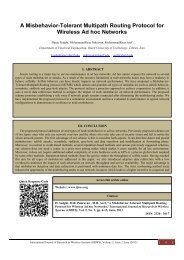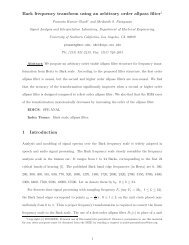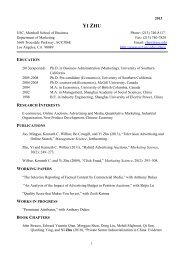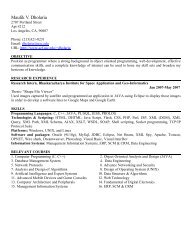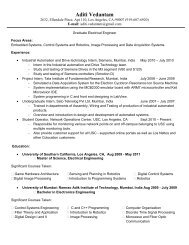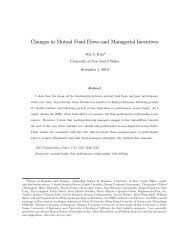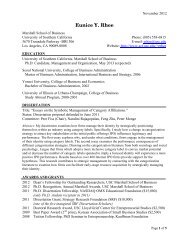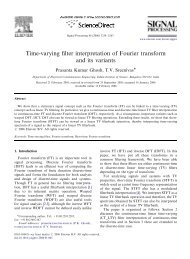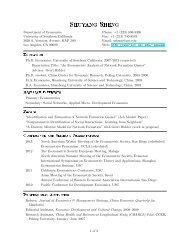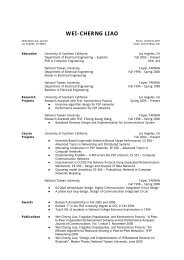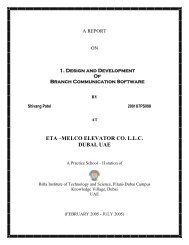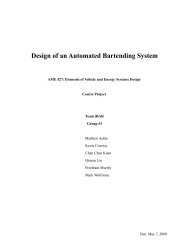Tempo and beat analysis of acoustic musical signals Introduction
Tempo and beat analysis of acoustic musical signals Introduction
Tempo and beat analysis of acoustic musical signals Introduction
You also want an ePaper? Increase the reach of your titles
YUMPU automatically turns print PDFs into web optimized ePapers that Google loves.
<strong>Tempo</strong> <strong>and</strong> <strong>beat</strong> <strong>analysis</strong><br />
<strong>of</strong> <strong>acoustic</strong> <strong>musical</strong> <strong>signals</strong><br />
Previous work<br />
Author:<br />
Eric D. Scheirer<br />
Presenting by:<br />
Wan-chi Lee<br />
ISE575: Feb 3, 2005<br />
n Previous work focus on symbolic<br />
data, or try to extract high-level<br />
information before tracking <strong>beat</strong>.<br />
n This research try to avoid the<br />
“transcriptive” <strong>analysis</strong>.<br />
<strong>Introduction</strong><br />
n Goal: automatic extraction <strong>of</strong> rhythmic<br />
pulse (<strong>beat</strong>-tracking)<br />
n Like peoples do when they foot tapping with<br />
music<br />
n Beat: “the sense <strong>of</strong> equally spaced<br />
temporal units”<br />
n Defining tempo<br />
n Grouping, Strong/Weak relationship is not<br />
considered.<br />
Psycho<strong>acoustic</strong> demonstration<br />
1
Algorithm<br />
Envelope Extracting, Differentiator<br />
, Rectifier<br />
n Rectified-<strong>and</strong>-smooth:<br />
n Smooth by a 200-ms half-Hanning<br />
window.<br />
n Decimation:<br />
n Downsample to 200Hz sampling rate.<br />
n Differentiated<br />
n Half-wave rectified<br />
Frequency Filterbank<br />
n 6 filter divide signal to 6 subb<strong>and</strong>:<br />
n ~200, 200~400, 400~800, 800~1600,<br />
1600~3200, 3200~<br />
n Sixth-order elliptic filter:<br />
n Sharp cut<strong>of</strong>f<br />
n 3dB ripple in passb<strong>and</strong><br />
n 40dB <strong>of</strong> rejection in stopb<strong>and</strong><br />
Examples<br />
2
Resonators Filterbank<br />
n Each comb filter has the form:<br />
n y(t)=£\y(t-T)+(1-£\)X(t)<br />
n Giving larger output while the input is<br />
<strong>of</strong> period T (or multiple, factor <strong>of</strong> T).<br />
n Output value from different subb<strong>and</strong><br />
filter with the same T are added to<br />
determine the tempo<br />
Beat Phase<br />
n The time when the next <strong>beat</strong> will<br />
arrive can be predicted:<br />
n The value in the delay lattices can be<br />
viewed as “predicted output”, in the<br />
case <strong>of</strong> zero input.<br />
n Performed every 25ms.<br />
Comparison with the<br />
autocorelation methods<br />
n Advantage:<br />
n Gives phase information, predict next<br />
impulse.<br />
n Disadvantage:<br />
n Less efficient in memory usage.<br />
3
Parameters to tune<br />
n Frequency filterbank<br />
n Envelop sampling rate<br />
n Oversampling is required<br />
n Number <strong>of</strong> resonators<br />
n Analysis frame rate<br />
Conclusion<br />
n An algorithm for <strong>beat</strong>-tracking<br />
digital format music.<br />
n Some problem unsolved:<br />
n Best number <strong>of</strong> b<strong>and</strong>s used?<br />
n Errors:<br />
• Up<strong>beat</strong>/down<strong>beat</strong>, quarter-note/ eighthnote<br />
discriminating.<br />
n Other Structure: two-level?<br />
Validation<br />
4




